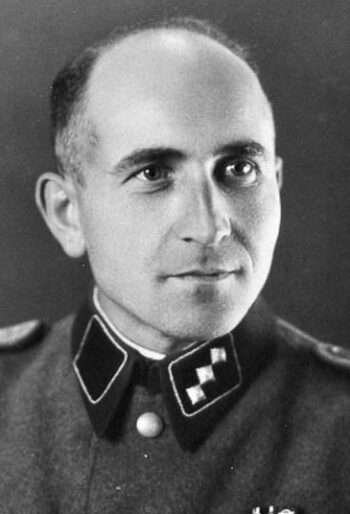Grabner, Maximilian

Maximilian Grabner (2 Oct. 1905 – 24 Jan. 1948), SS Untersturmführer, was a detective with the Vienna police, and later with the State Police at Kattowitz. In June 1940, he was transferred to Auschwitz to become head of that camp’s Political Department. In December 1943, he was arrested for unlawful appropriation of inmate property (embezzlement) and sentenced to 12 years’ imprisonment by an SS tribunal.
The Political Department was in charge of the camp’s cremations in its crematoria. Since these buildings were also claimed to be the location of gas-chamber mass murder, Grabner logically was accused of bearing co-responsibility for them, organizing and supervising the alleged homicidal gassings. After the war, he made the following incriminating statements in this regard:
- Starting in early 1942, several gassings were carried out in the basement cells of Block 11. The orthodoxy insists, however, that only one such gassing took place in this building, the infamous first gassing in early September 1941, although that fictitious event is refuted by genuine wartime documents. (See the entry on First Gassing, at Auschwitz.)
- 300,000 dead inmates were buried in 1941 and 1942 due to lack of cremation capacity. The orthodoxy insists on some 100,000 buried inmates, but wartime air photos set the figure closer to 10,000 to 20,000. (See Rudolf 2020a, p. 119.)
- In order to erase the traces of this mass murder, orders came from Berlin in 1942, after the discovery of the Katyn mass graves, to unearth and burn the corpses. However, Katyn was discovered only in April of 1943. (His former subordinate Pery Broad told the same lie, suggesting that these false ideas were planted by their interrogators.)
Grabner further testified against his fellow camp officers, “confessing” the most absurd charges:
- He affirmed three times that the Auschwitz death toll during his presence at the camp (to the end of 1943) amounted to “at least three million.” (Orthodoxy insists on 1 million, for the entire life of the camp.)
- At another interrogation, he set that figure even higher: “some 3 to 6,000,000 people.”
- He blamed it all on the former camp commandant Rudolf Höss, whom Grabner described as a merciless and blood-thirsty man.
- Grabner claimed to have sabotaged the mass murder wherever he could, in one case by damaging the two large Birkenau crematoria by pouring “used engine oil into the chimney.” – But imagine the camp’s top Gestapo officer secretly clambering up the 25 iron steps of the 15m-high chimney, single-handedly, while holding a large can of used engine oil in one hand… (without that oil doing anything to the furnaces at the other end of the smoke ducts…)
- On another two occasions, he claimed to have poured oil into the smoke duct where it meets the chimney (although there is no opening to allow this to happen), and the second time he did that, the chimney blew up, together with the furnaces! Engine oil is not explosive, however.
- Grabner seriously claimed that Auschwitz had been set up as an extermination camp already in April 1940 “by an order from Berlin.”
We will likely never know the conditions that compelled him to testify thusly. Physical and psychological torture were commonplace, as were vague (and false) promises of acquittal. Oftentimes, the Allied (often Jewish) interrogators would draft their own version of a “confession” statement and then pressure the accused to sign it. This is implied here, based on Grabner’s own words, written while he was in a prison of the occupation force in Austria:
“The signatures on the reports drawn up in the course of these investigations are in my own hand, but in the formulation of the content of these reports I had no influence, because I had to sign them as a result of the methods employed during my interrogations.”
Grabner ended up as one of the most prominent among the defendants during the Polish show trial against members of the former Auschwitz camp garrison. Despite his cooperative testimony, he was sentenced to death on 22 December 1947, and subsequently hanged. (For details, see Mattogno 2016c, pp. 63-67; 2022f, pp. 117-126.)

You need to be a registered user, logged into your account, and your comment must comply with our Acceptable Use Policy, for your comment to get published. (Click here to log in or register.)